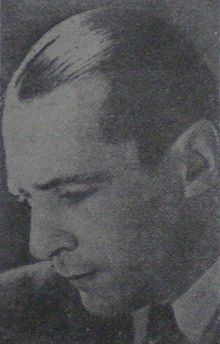Enrique Amorim
Enrique Amorim (born July 25, 1900 in Salto ; † July 28, 1960 there ) was a Uruguayan writer. With a strong closeness to his homeland and nature and an eye for social injustice, he mainly described in his narrative prose the life of the gauchos and farm workers in the pampas or in the slums of Montevideo . His most highly regarded novels are La carreta (1929), El paisano Aguilar (1934) and El caballo y su sombra (1941). At an advanced age, Amorim joined Uruguay's Communist Party .
Life
Amorim grew up on a large estancia (cattle ranch ) in northern Uruguay . His wealthy father was of Portuguese origin. Amorim traveled extensively in Europe and Latin America and developed acquaintances and friendships with many of the leading writers of his time. He later had a house designed by Le Corbusier built in his birthplace .
In the 1920s, Amorim wrote for the Argentine leftist magazine Los Pensadores , published by the Claridad printing company. Both the magazine and the print shop were associated with the left-wing Grupo Boedo , which got its name from the Boedo district in Buenos Aires .
In 1947 Amorim officially joined the Communist Party of Uruguay . He was also in charge of the erection of a monument in Salto in honor of the Spanish writer Federico García Lorca .
Although he devotes himself to the brutal and often dirty realities of country life, writes Harley D. Oberhelman, Amorim tells with tenderness and compassion about the people affected and also the overwhelming beauty of the motionless landscape.
Works
Novels
- La carreta , 1929, German Die Carreta (die Karre / das Fuhrwerk), Berlin 1937
- El paisano Aguilar , 1934
- La edad despareja , 1938
- El caballo y su sombra (The horse and its shadow), 1941
- La luna se hizo con agua , 1944
- El asesino desvelado , 1946
- Feria de farsantes , 1952
- Eva Burgos , 1960
Short story collections
- Amorim , 1923
- Horizontes y bocacalles , 1926
- Tráfico , 1927
- La trampa del pajonal , 1928
- Del 1 al 6 , 1932
- La plaza de las carretas , 1937
- Después del temporal , 1953
Poems
- Veinte años , 1920
- Visitas al cielo , 1929
- Poemas uruguayos , 1935
- Dos poemas , 1940
- Primero de Mayo , 1949
- Quiero , 1954
- Sonetos de amor en verano , 1958
Plays
- La segunda sangre , 1950
- Don Juan 38 , 1958
literature
- Alicia Ortiz: The Novels of Henry Amorim , Buenos Aires, 1949
- Harley D. Oberhelman: Contemporary Uruguay as seen in Amorims first cycle , in: Hispania , Vo. 46, No. 2, May 1963, pp. 312-318
- Brenda V. De López: En torno a Enrique Amorim , Montevideo 1970
- KEA Mose: Enrique Amorim: The Passion of an Uruguayan , Toronto 1970, Madrid 1972
- Frank Scott Helwig: Narrative Techniques in the Rural Novel of Enrique Amorim , in: Graduate Studies on Latin America , University of Kansas, 1973, pp. 83-91
- Santiago Rojas: Protesta y compromisso en la obra narrative de Enrique Amorim , University of California 1977
- Santiago Rojas: Gaucho y paisano en Amorim: Del mito a la realidad , in: Explicación de textos literarios , 7, 1978/79, No. 2, pages 185-192
Web links
Individual evidence
- ^ David William Foster, in: Books abroad , Vol. 47, No. 3, Summer 1973, 537
- ^ Roberto Gonzáles Echeverría (Ed.): The Oxford Book of Latin America Short Stories , Oxford 1997, p. 201
- ↑ See Museum in Amorim Strasse , accessed April 2, 2012
- ↑ Harley D. Oberhelman: Enrique Amorim as an Interpreter of Rural Uruguay , in: Books Abroad , Vol. 34, No. 2, Spring 1960, pp. 115-118
- ↑ A number of Amorim's works have been translated, but Die Carreta is the only German one so far.
- ^ For Oberhelman (1960) the best of all Amorim's rural stories. She unites all the motifs from previous works, such as hardship, loneliness, prostitution, into a “contemporary saga of the pampas”. Kindler's Neues Literaturlexikon (Munich 1988 edition) attests to her not only powerful descriptions of the landscape but also of “blatant drama” in the plot.
| personal data | |
|---|---|
| SURNAME | Amorim, Enrique |
| BRIEF DESCRIPTION | Uruguayan writer and poet |
| DATE OF BIRTH | July 25, 1900 |
| PLACE OF BIRTH | Salto (Uruguay) |
| DATE OF DEATH | July 28, 1960 |
| Place of death | Salto (Uruguay) |
